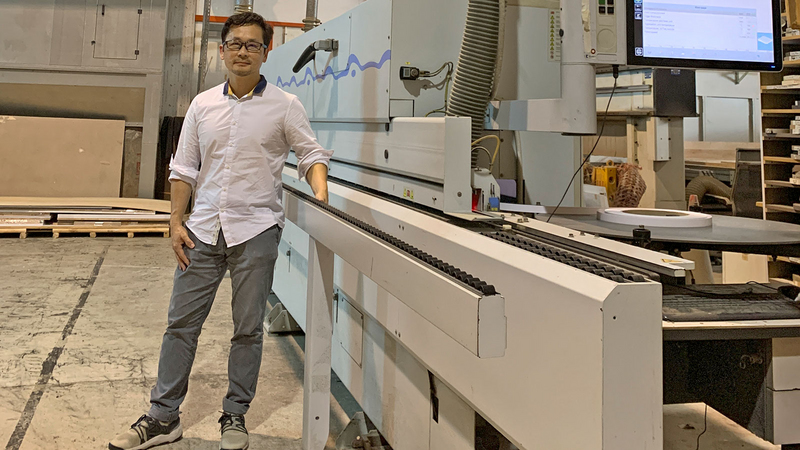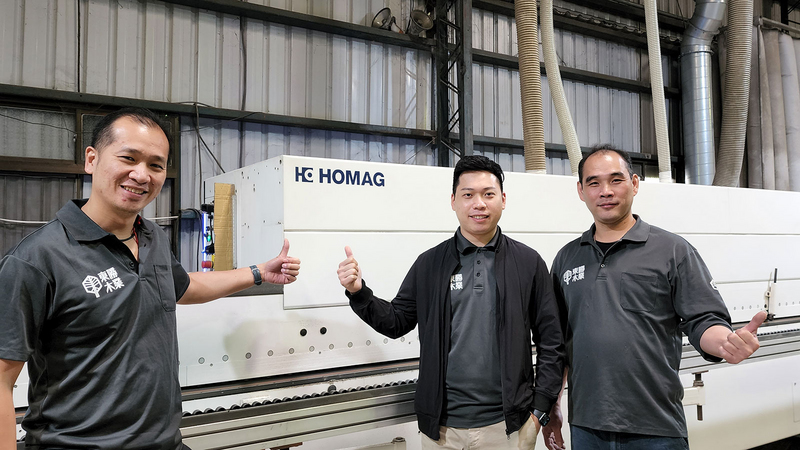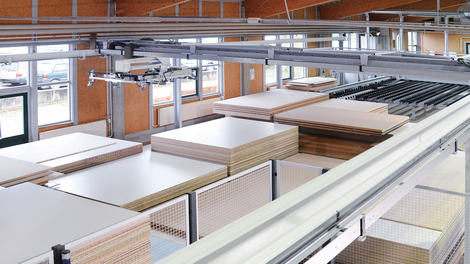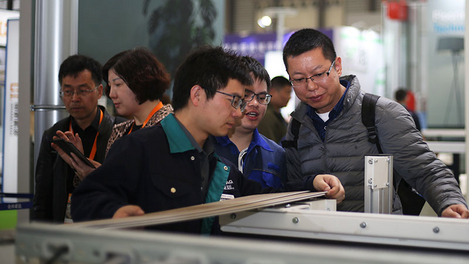Sixty years of edgebanding quality
Furniture manufacturers today are arguably familiar with HOMAG’s EDGETEQ series of edgebanding machines, but it is the history of the manufacturer’s innovation that has helped accelerate the group’s reputation as a specialist in this segment. This year, as HOMAG celebrates 60 years of edgebanding excellence, witness how their edgebanding technology has evolved and improved in breadth, complexity and performance.
Sixty years ago, HOMAG launched its first throughfeed edgebanding machine using the hot-cold application process. The machine was well received by the industry, and what followed over the years was a series of innovations and further developments.
Hitting milestones from the beginning
In 1962, two years after the company was founded, HOMAG registered a patent for what was reportedly the first automatic edgebanding machine, the KH 2/18, a series machine with a veneer strip magazine, gluing unit, pressure zone and flush trimming unit. This technology was to become the starting point for almost all further developments by HOMAG in this segment. In the same year, at the Hanover trade fair, HOMAG launched a new type of edgebanding machine that utilised the hot-cold application process. In comparison to competitors, this machine allowed edges to be glued faster and more economically.
From then on, HOMAG concentrated on the production and further development of this gluing technology, and the process was further driven in particular by an innovative glue technology: hot-melt glue.
In 1965, HOMAG launched a double-sided edgebanding machine with a new base frame- and width-adjustment device. Two years later, they developed the first single-sided edgebanding machine: the KH 12.
Another milestone in furniture production was reached with the KF series, as it was the first combined sizing and edgebanding machine, as claimed by HOMAG. The KF 60 also incorporated snipping and sanding units in addition to edgebanding and flush trimming. Today, up to 15 units are installed on these types of machines, allowing workpieces to be processed in a way that makes them ready for installation.
To offer smaller furniture companies a suitable edgebanding machine, HOMAG launched the KH 10-13 series in 1973. These machines were offered with two different gluing stations to allow coil material, solid edges and pre-coated edges to be processed.
At the 1975 LIGNA trade fair, HOMAG presented the cold-glue activation process to the industry for the first time — a technology for edge gluing using polyvinyl acetate (PVAc) glue.
The following year, a majority stake was acquired in Heinrich Brandt, later BRANDT. This move strengthened HOMAG’s position in the woodworking sector.
In 1982, a new generation of edgebanding machines, the KL 70, was shown at a trade fair for woodcraft in Munich, Germany. Fundamental innovations in construction, versatility and work safety were implemented in these machines, particularly the mechanical air-supported chip removal, which was integrated into the stand and reduced required suction power by 70%. The machine was further developed to become, for example, the KL 70 Optimat in 1995.
In 1999, HOMAG launched its powerLine series, a range of double-sided machines designed for series production. According to HOMAG, they offered a 50% increase in performance at just 30% additional cost, achieved with higher feed speeds, shorter gaps and changeover times, and longer availability.
Small series production and individual production became more and more important in the following years.
In 2001, HOMAG presented a new automated generation of the powerLine series for batch-size-one production.
In 2004, HOMAG responded to the growing use of lightweight panels and began offering machines and systems not only for the production but also for the further processing and edging of these panels.
HOMAG was again able to celebrate a world premiere at LIGNA 2009, through the launch of the Ambition series of edgebanding machines in the form of six series from BRANDT and HOMAG.
The basic version of the series covered over 90% of all applications required in woodworking factories, and in 2014, the next generation of the Ambition series followed, featuring new unit technology and models in various performance classes.
A new age in edge processing
The introduction of the laserTec process in 2009 heralded a new age in edge application. Using a laser beam to melt the surface to be glued and then pressing it directly onto the workpiece, the laserTec process ensured a consistently high processing quality with almost no joints. It could also process all standard edge types, including polyvinyl chloride (PVC), acrylonitrile butadiene styrene (ABS), polypropylene (PP), polymethyl methacrylate (PMMA), veneer and melamine. Introduced in 2017, the laserTec Next Generation was available in two performance classes and offered the industry zero-joint edge quality in both batch-size-one and series production.
In 2013, airTec was launched for the processing of invisible joints using hot air, for special edges with both decorative and functional layers. Melted at a constant temperature and volume flow, the functional layer can be securely connected to narrow surfaces. Since 2016, the airTec unit has been available with a rotation air heater, making it quieter and more powerful. In 2017, the process was established in door production, allowing the manufacturing of optical zero joints with ABS or PP edge material.
The EDGETEQ era
After the consolidation of HOMAG Group and its companies in 2017 into a single HOMAG brand, the group launched a whole series of new machine generations that covered the entire process chain and combined new functional designs. From then on, HOMAG’s edgebanding machines bore the name EDGETEQ and the technology has continued to develop to meet changing market needs.
The entry-level EDGETEQ S-200 machine, model 1130 FC, was launched in 2018, followed by the new EDGETEQ S-500 and EDGETEQ S-800 series. In 2021, the company kept up with the market shift toward autonomous and automated production systems by introducing two cell solutions with edgebanding machines: an EDGETEQ S-380 with LOOPTEQ O-300 return conveyor, ideal for the production of construction elements, and an EDGETEQ S-500 with LOOPTEQ O-600 return conveyor and a new workpiece infeed system for workpieces requiring a particular sizing accuracy.
To be at the forefront of further digitalising manufacturing in woodworking, HOMAG has emphasised ensuring that software and machinery are integrated for better data generation, management and utilisation, as well as diagnostic capabilities.
The current milestone in the software sector for the EDGETEQ was marked in 2022 by woodCommander 5 with Edge Data Plugin on the EDGETEQ S-500 edgebanding machines. This enables quick selection of processing programmes and edge materials, as well as the recording of production parameters and the workpiece-oriented creation of machine programmes. In addition, it forms the direct connection between the machine and the materialAssist application, which manages the edging material.
Partnering growth in the industry
In edge processing, the range of services offered by HOMAG today extends from individual machines in the entry-level, medium- or high-end segment, through the engineering and installation of complex production lines and systems, to complete industry solutions, including consulting and software. With this machine and service range, the group continues to offer a product range with customer benefits.
Meicha Furniture, a Taiwanese do-it-yourself furniture manufacturing company since 1973, has been using the same HOMAG edgebanding machine acquired in 1987 to create its soft-forming edges, alongside newer units.
“We are impressed by the quality, durability and stability of HOMAG’s machines. As a trusted brand, HOMAG is always the first we consult whenever we have needs for edgebanding machines,” said Bing Chen, factory manager at Meicha.
Meicha Furniture has since acquired other HOMAG models over the years, including the EDGETEQ D-610, EDGETEQ S-500 and TENONTEQ D-500, among others, to optimise production and increase efficiency for their larger honeycomb panels.
“The high-quality edgebanding machines, combined with our special panels, increase our productivity and give us high-quality edges that are recognised, appraised and trusted by customers worldwide — even by our European customers who have many more options in their region,” added Chen. “We would like to emphasise the smooth production and high productivity for serial or small-batch production, especially larger honeycomb panels; high quality and precision can be achieved thanks to the double-sided edgebander.”
Singapore-based Sen Wan Group, a plywood and wood panel supplier, echoed HOMAG’s consistency in producing high-quality edging amid a high production volume of 1,000 parts per shift for furniture parts and 3,000 boards per shift for lamination.
“Because we deal with all types of plywood surfaces, one of the most important features of HOMAG’s edgebanding machines is the automated calibration to suit each batch of incoming materials,” explained Ashton Chan, group executive director of Sen Wan Group.
“Even if you have 100 very skilled carpenters to do edging, typically there would still be inconsistent quality and all of them would need to know how to manually calibrate the machine according to the material,” continued Claudia Eio, director of innovation at Sen Wan Group. “HOMAG’s machine calibration is automated and saves time and skilled manpower. It allows production to be seamless, saves a lot of time and increases the consistency of the quality.”
Besides the high-quality edgebanding process offered by the HOMAG KDF 110 and HOMAG KDF 650 edgebanding machines purchased in 2016, Sen Wan has also experienced optimal after-sales service from the HOMAG team.
“For so many years, we have never felt that if something goes wrong with production or the machine, we would be left in the lurch. Once, there was a software system issue that needed attention and the engineers were even able to connect to the machine from Germany to conduct diagnostics and resolve the issue on the spot,” commented Chan.
For Dongsheng Cabinets & Wardrobes in Taiwan, which retails systems furniture for residential homes, the EDGETEQ S-500 edgebanding machines purchased in 2018 and 2021 are stable, straightforward and user-friendly. They are also flexible and adaptable, producing high-quality edges to meet the diverse and changing demands of customers.
“With increasing levels of demand and sophistication, customers are starting to pay attention to details such as perfect edges and drilling. With more demand comes more choices, ultimately giving consumers better ability to select only the best among a wide variety of options,” expressed Lo Yu-Ming, owner of Dongsheng Cabinets & Wardrobes. “The highly stable and high-yield HOMAG machines produce these quality parts and furniture that build trust and confidence among end-users.”
HOMAG declared that it will continue to be a partner to manufacturers of all sizes as the industry progresses and evolves to meet ever-growing customer needs and quality demands.







